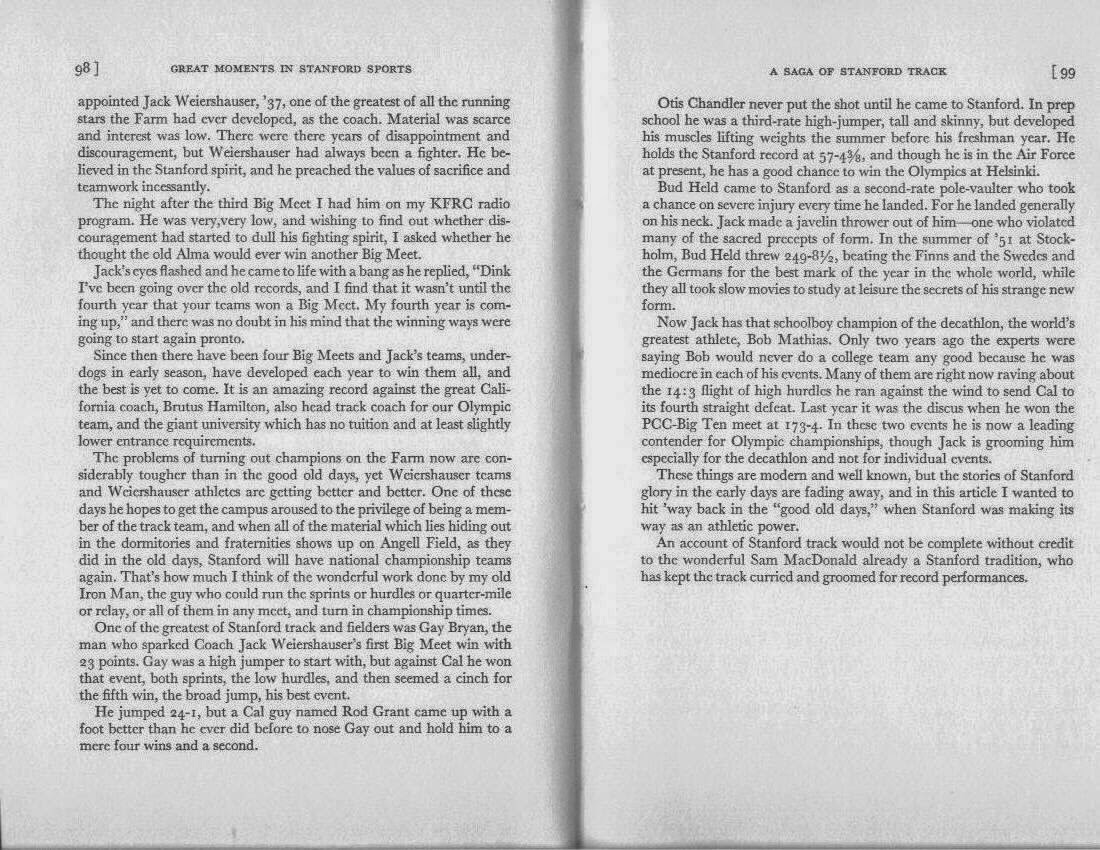While waiting for reception (via US Postal Service and Canada Post combined, don't hold your breath) of the US USSR 1964 meet program promised by my colleague Roy Mason for insertion into our report of said meet, I've decided to move forward with the posting of a rare piece of track and field literature. Recently I found a book on Stanford athletic history in a second hand store. The book was published in 1952, and Dink Templeton, a former Stanford track coach turned journalist contributed a chapter on Stanford track and field and "The Big Meet" ie. the Stanford -Cal dual meet. Remember he was writing this in 1951 and was talking about the 'old days' relative to that time frame. The accounts go back to before WWI and focus on the importance of the dual meet and how a less than top rung team member could turn the tide in a dual. Remarkably the athletes also seemed to have some negotiating skills with the meet officials, in one particular case getting a last chance to go for a long jump after the mile relay was finished, and winning the meet with a superhuman effort. Of note too is that some of the California schools were in the IC4A and schools travelled east and west for their annual competition.
I haven't been able to find any pictures of the really old days at Cal or Stanford showing some of those competition, but I'm sure they exist in some archive in one of those venerable schools' libraries. If anyone can come up with pictures, please send them to us for inclusion in this article.
Following the account by Templeton, Bill Flint, a former polevaulter at Stanford has sent us an account of his experience jumping under Templeton's mentorship at the San Francisco Olympic Club. Bill also has some comments on the the turnover of coaches and the advent of Payton Jordan. Thanks, Bill for your comments.
George,
First of all, many thanks for all you do with the blog --- I always look forward to reading it even though you runners dominate the coverage!
The Dink Templeton articles really brought back memories ---in 1957 and 58 I was still at Stanford but 1956 was my thislast college eligibility year. So in 57 and 58 I competed for the San Francisco Olympic Club and Dink was my coach. I can still hear his raspy voice yelling "PULL" at me in the middle of my vault.
Back to 1956--Jack Weiershauser's last year as Stanford's track coach. Payton Jordan was to replace Jack in 1957 ---this would be the first time a "non Stanford man" would be coaching track and Jack was concerned future tracksters would loose the Stanford track past. So Jack put together a dinner for us and had Dink be our guest speaker. I still remember that occasion as a very special evening --- many of the stories in the above article were told that evening and delivered in a way only Dink could ---thanks, George, for allowing me to relive that time.
A sidelight ---Jack was fired (we all hated the treatment he got) but he never shared his feeling about that with any of us as far as I know. Many years later Payton Jordan told me that when was approached about the Stanford job, he called Jack ( his longtime friend) and said he wouldn't be party to this shabby treatment and would not accept the job. Jack's reply was in effect, no, don't turn down this opportunity --- I'm history here and nothing can chsnge that. To me, this incident shows the great qualities of both of these men.
Bill

Beginning our 14th year and 1,200+ postings. A blog for athletes and fans of 20th century Track and Field culled from articles in sports journals of the day, original articles, book reviews, and commentaries from readers who lived and ran and coached in that era. We're equivalent to an Amer. Legion post of Track and Field but without cheap beer. You may contact us directly at irathermediate@gmail.com or write a comment below. George Brose, Courtenay, BC ed.
Once Upon a Time in the Vest
Subscribe to:
Post Comments (Atom)
V 15 N. 10 Gunder 'The Wunder' Haegg Visits Cincinnati
Bob Roncker of Cincinnati, Ohio has sent in this account of one day on the 1943 tour that Gunder Haegg of Sweden made to the US to help rais...

-
Bob Roncker of Cincinnati, Ohio has sent in this account of one day on the 1943 tour that Gunder Haegg of Sweden made to the US to help rais...
-
This posting was inspired by the piece we did a few months ago on the members of the 1960 Olympic track and field team who had passed away....








No comments:
Post a Comment